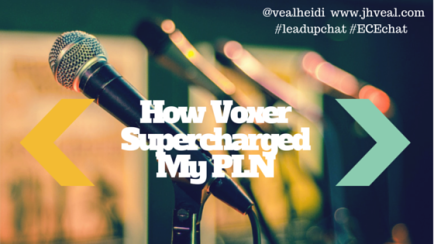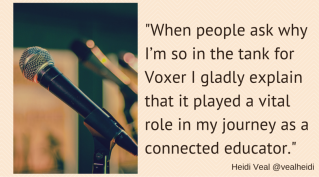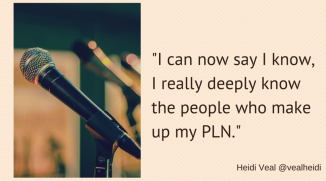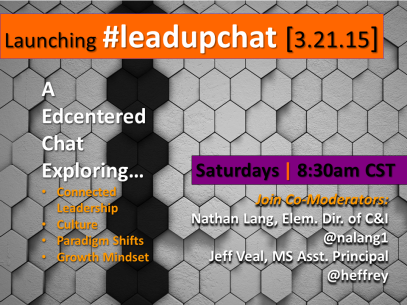
I was first introduced to the Voxer app fall of 2014 at a Saturday PD I attended near my home town. It was described in a “this app is on its way out” way because, at that time, Apple had just released iOS 8 which possessed competing voice messaging features in their new updates. Fellow workshop attendees briefly described Voxer’s attributes and dismissed it as quickly as the app had been brought up.
In short, Voxer is a walkie-talkie app that allows users to communicate via tap-to-talk voice recorded messages, unlimited length texting, and picture posts too. Despite the dismissive nature of my introduction to Voxer, I decided to investigate it anyway, especially after hearing how a connected educator in my school district used it to connect with her PLN. I downloaded the app along with a colleague and thus began my Voxer plunge!
My first forays into Voxer started off by joining a pre-existing group of educators. Over several weeks, I listened in on the conversation, feeling more like a voyeur, and left a few Voxes (that’s what you call a voice message on Voxer). My first impressions with Voxer left me thinking several things: This is remarkable, but who has time for this; I’m so nervous leaving a voice Vox; I don’t know these people, but they seem to be pretty connected. I ended up leaving that group and joining a few different groups, committed to giving it a fair shake at finding a group I connected with. I also used Voxer to communicate directly with a college who was a Voxer newbie. We eventually stumbled upon a newly forming group doing a book study on Eric Sheninger’s book Digital Leadership. We both joined the new Voxer group at the start of 2015, engaged in the book study that ended up lasting several months, and from that point I was sold on Voxer!
Since that time, Voxer has become a mainstay app for me, soon finding its way into my iPhone’s Dock as one of the four chosen Apps of Honor. I also took the plunge to become Pro, which was probably the most I have ever spent on an app, but was money well spent in my opinion.

When people ask why I’m so in the tank for Voxer I gladly explain that it played a vital role in my journey as a connected educator. It is the tool that propelled my Professional Learning Network into a Powerful & Personal Learning Network. Pre-Voxer, I connected on Twitter much like many other educator. As regularly as possible, I participated in Twitter chats such as #EduCoach and built a traditional PLN by following and learning with/from educators who inspired me and were experts in their fields. I also shared out things I was learning and helpful resources that were meaningful to me with others.
Twitter was a great place to connect and grow, but I did not recognize what I do now. It was challenging to forge a PLN with authentic community and connectedness via Twitter alone. For me, Twitter was as wide as the east is from the west, but rather shallow when it came to deep connections. I felt limited by the 140 characters and rushed by the fast pace of most chats. So much of the interaction I experienced on Twitter alone was surface deep. Please don’t get me wrong though, Twitter did and continues to play a critical role in my growth as a connected educator, but I attribute Voxer with propelling me to the next level of connectedness. Voxer is where my PLN shifted from being strictly a P(rofessional)LN via single tweets of interaction to being Powerful and Personal, increasing in depth via the variety Voxer provides for communicating and connecting. Voxer has allowed me to interact far beyond a tweet by connecting at my own pace and utilizing a mix of text, voice message, picture, and resource sharing.
Today, I wouldn’t be the connected educator I am without Voxer. It has afforded many unique opportunities such as growing with the LeadUpNow tribe as a founding member of their Voxer group, co-blogging with Bethany Hill, co-presenting at my state technology conference with Matthew Arend, Ryan Steel (both whom I met via Voxer), and Nancy Alvarez, and meeting Eric Sheninger as a result of the Digital Leadership book study Voxer group (which is now reading his new book Uncommon Learning).

I can now say I know, I really deeply know the people who make up my PLN. We aren’t just a brief bio and profile pic to one another, but friends who share about our families, our personal hurdles, our professional triumphs, our areas of growth, and our dreams and work as educators.
Have I mentioned the incredible growth Voxer has afforded me? Thanks to Voxer, I experience powerful, impassioned, just-in-time professional growth from educational thought leaders across the country on a daily basis! I equate it to on demand PD, anytime and anywhere! All these reasons combined lead me to believe that Voxer is an app that is here to stay for quite some time.
I want to share some of my favorite ways to use Voxer and why I think it’s an app that could help propel your PLN too!
Groups
Collaborating in groups is my favorite way to use Voxer! I participate in several groups on a regular basis, but my core PLNs are the ones I spend the most of my time interacting with, those being the ECEchat and LeadUpNow groups. As a Voxer Pro subscriber, I am able to create and administrate the groups I create. I also connect with my own campus’s Leadership Teams as well as the Assistant Principals in my district via a Voxer group. We are able to communicate and collaborate as a group on an ongoing basis using this versatile and free app.
Book Studies
Voxer is a great platform for a book study! A group can come together to read a book over a period of time. As mentioned, I did a book study with a group reading Eric Sheninger’s book Digital Leadership. He actually was a part of the group too and would chime in from time to time. Recently, the group reconvened to read his second book, Uncommon Learning, and Eric is participating with us again. What an unique opportunity that only Voxer affords! We use a repeating set of questions allowing members to chime in each day to share their response to the question and interact about the content of the chapter for the week. Doing book studies on Voxer has been a great way to gain greater insights into the professional books I read, connect and grow with people in my PLN at a deeper level, and have accountability for reading and implementing new learning.
Email a Voice Vox
Voxer users are able to record a voice Vox in their “My Notes” and email it to another person even though they may not have a Voxer account. The emailed voice message is played through a Voxer web link. I use this feature to record and email voice messages to teachers after I visit their classrooms to give them informal, immediate feedback. I like that they can hear the enthusiasm in my voice after I’ve visited their classrooms.
Keeping in Touch with Friends & Family Across the Miles
Voxer is terrific for keeping in touch with loved ones far away. I specifically use it to connect with my mother who lives states away from me. She doesn’t have a smartphone, but she does have an iPad so we Vox on a regular basis. My kids even Vox her sometimes. They especially love sending her pictures. It’s nice that we can send her a quick voice message or hear from her any convenient time.
How do you like to use Voxer? I’d love to hear your ideas! If you have not tried Voxer, I highly encourage you to give it a go. Check out Cybrary Man’s All About Voxer web page to learn more about Voxer and to find a group to connect with today. Voxer’s blog site is also a great place to learn more about the power of Voxer!
 If we are self-directed learners, we thrive and crave on feedback. Let’s say we’ve bought into authentic, learner centered instruction. The data we collect from an assessment can help to inform next steps for students in the learning process but it doesn’t exclusively guide student learning.
If we are self-directed learners, we thrive and crave on feedback. Let’s say we’ve bought into authentic, learner centered instruction. The data we collect from an assessment can help to inform next steps for students in the learning process but it doesn’t exclusively guide student learning.

